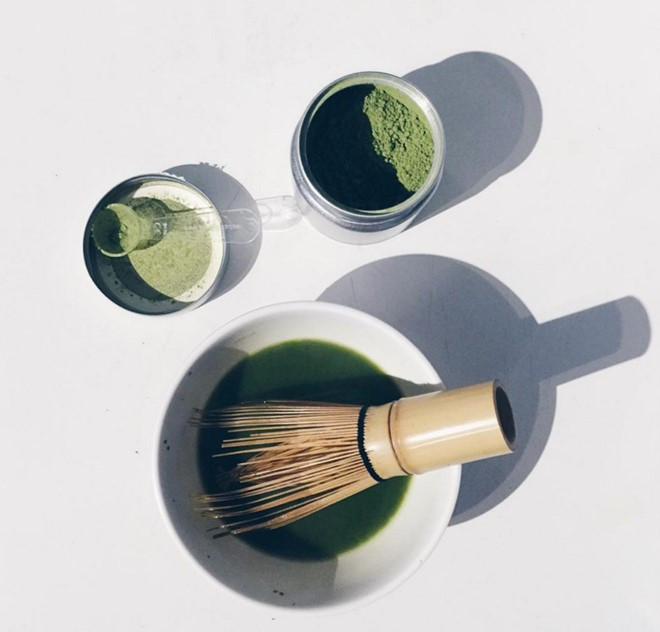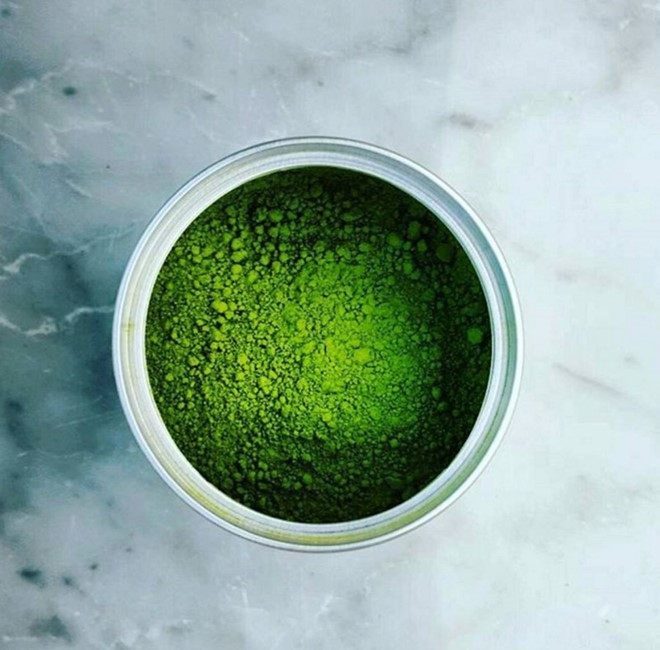Matcha secrets you may not know
Japanese green tea is a favorite ingredient for many diners. There are some interesting secrets about this delicious, nutritious food that you may not know.
Matcha has become a familiar ingredient in cuisine, commonly used in restaurants and bakeries, and has many health benefits.
1. Matcha made from tea leaves, not soaked in water.

Matcha is pure crushed powder from tea leaves.(Photo: @ kylebc86 / Instagram).
Matcha means "pure leaf meal". When drinking matcha, you are enjoying tea leaves, not leaf-soaked water. Therefore, together with tea grown in shade, matcha contains more nutrients and antioxidants than green tea. After harvesting and drying, tea leaves are ground into fine powder.
2. Matcha originated in China, but became popular in Japan
Growing green tea originated in China during the Tang Dynasty (7th-10th century), then used in Buddhist meditation ceremonies. Around the 12th century, tea powder was brought from China to Japan. When green tea fades in popularity in China, Japanese monasteries and aristocracy have embraced this food.
Due to complex processing, most people have no chance to use matcha until a more efficient production method appears around the 18th century.
3. A matcha cup contains 10 times more antioxidants than regular green tea

Matcha contains a special class of antioxidants called catechins.(Photo: @ kissatea / Instagram).
Since matcha is almost pure tea leaves, you will get the full benefits of tea, which has more antioxidants than other foods like pomegranate, blueberry and acai fruit.
Matcha tea also contains a special class of antioxidants called catechins, not found in other foods. They counteract the effects of free radicals that stem from pollution, ultraviolet rays, radiation and chemicals that can damage cells and DNA.
4. Not all matcha are the same, some are very expensive
Consumers who know matcha can be very expensive with a variety of quality options. Matcha is divided into two categories: koicha with more pure tea, and less usucha.
Due to different ingredients, these matcha types are also used for different purposes. The highest grade matcha has the brightest color and the best taste costs about 1 USD / gram. The lower the quality of Matcha, the more opaque the color and the more bitter taste.
5. L-Theanine in matcha helps you stay awake longer than coffee
Coffee still contains more caffeine than matcha. However, thanks to an amino acid called L-Theanine that increases the amount of dopamine and serotonin, matcha helps you relax and concentrate throughout the day.
6. Drink matcha for health and help lose weight

Matcha has many health benefits, including weight loss.(Photo: @jadeleafmatcha / Instagram).
Studies have shown that matcha can enhance the body's ability to burn fat up to 4 times the normal level. But remember that this does not include matcha cream, smoothies or donuts, but just tea with almost no calories.
7. Matcha latte limits the effect of matcha
Matcha latte with a gentle combination of tea and warm milk, is a favorite drink of many people. However, a milk protein called casein that binds to catechins in matcha limits health benefits.
- Miraculous mental health effects of a passionate youth drink
- Tea is 10 times better than green tea
- 7 reasons for students 'grade C' in the world
- Discover secrets from tombs
- Horror secrets were discovered in 2013
- 10 unexplored secrets about sperm
- The US is afraid of revealing state secrets for Chinese components
- Harvard experts share secrets to always win when debating
- Secrets that are sure you never know about sports stadiums
- Chemical secrets of love
- The secret secrets are not only knowledgeable travelers
- Deciphering secrets in married life
 'Fine laughs' - Scary and painful torture in ancient times
'Fine laughs' - Scary and painful torture in ancient times The sequence of numbers 142857 of the Egyptian pyramids is known as the strangest number in the world - Why?
The sequence of numbers 142857 of the Egyptian pyramids is known as the strangest number in the world - Why? History of the iron
History of the iron What is alum?
What is alum?